The Role of Cell Wall Polysaccharides Disassembly and Enzyme Activity Changes in the Softening Process of Hami Melon (Cucumis melo L.)
Abstract
:1. Introduction
2. Materials and Methods
2.1. Experimental Materials
2.2. Determination of Soluble Solid Content and Ascorbic Acid Content
2.3. Examization of Fruit Firmness, Weight Loss, Decay Incidence, and Respiration Rate
2.4. Ultrastructure of the Cell Wall
2.5. Extraction of Cell Wall Material
2.6. Separation of Cell Wall Polysaccharides
2.7. Determination of Lignin Content
2.8. Determination of the Molecular Weight of Cell Wall Polysaccharides
2.9. Analysis of the Monosaccharide Compositions of Cell Wall Polysaccharides
2.10. Determination of Cell-Wall-Modifying Enzymes
2.11. Statistical Analysis
3. Results and Discussion
3.1. Fruit size, Soluble Solid Content, and Ascorbic Acid Content in Hami Melons during Different Storage Stages
3.2. Analysis of Fruit Firmness, Weight Loss, Decay Incidence, and Respiration Rate
3.3. Ultrastructure of Cell Walls in Hami Melons
3.4. Cell Wall Material Content and the Change of Cell Wall Composition during Storage
3.5. Analysis of the Molecular Weight of Cell Wall Polysaccharides
3.6. Monosaccharides Compositions of Cell Wall Polysaccharides
3.7. Cell-Wall-Degrading Enzyme Activities
3.8. Correlation Analysis among Fruit Quality Characteristics and Cell Wall Components, as well as Cell-Wall-Modifying Enzymes in the Three Hami Melon Landraces
4. Conclusions
Supplementary Materials
Author Contributions
Funding
Institutional Review Board Statement
Informed Consent Statement
Data Availability Statement
Acknowledgments
Conflicts of Interest
References
- Zhou, R.; Wang, X.; Hu, Y.; Zhang, G.; Yang, P.; Huang, B. Reduction in Hami melon (Cucumis melo var. saccharinus) softening caused by transport vibration by using hot water and shellac coating. Postharvest Biol. Technol. 2015, 110, 214–223. [Google Scholar] [CrossRef]
- Wei, J.; Qi, X.; Cheng, Y.; Guan, J. Difference in activity and gene expression of pectin-degrading enzymes during softening process in two cultivars of Chinese pear fruit. Sci. Hortic. 2015, 197, 434–440. [Google Scholar] [CrossRef]
- Ren, Y.; Sun, P.; Wang, X.; Zhu, Z. Degradation of cell wall polysaccharides and change of related enzyme activities with fruit softening in Annona squamosa during storage. Postharvest Biol. Technol. 2020, 166, 111203. [Google Scholar] [CrossRef]
- Chea, S.; Yu, D.J.; Park, J.; Oh, H.D.; Chung, S.W.; Lee, H.J. Fruit softening correlates with enzymatic and compositional changes in fruit cell wall during ripening in ‘Bluecrop’ highbush blueberries. Sci. Hortic. 2019, 245, 163–170. [Google Scholar] [CrossRef]
- Chen, C.; Zhang, H.; Zhang, X.; Dong, C.; Xue, W.; Xu, W. The effect of different doses of ozone treatments on the postharvest quality and biodiversity of cantaloupes. Postharvest Biol. Technol. 2020, 163, 111124. [Google Scholar] [CrossRef]
- Koh, P.C.; Noranizan, M.A.; Nur Hanani, Z.A.; Karim, R.; Rosli, S.Z. Application of edible coatings and repetitive pulsed light for shelf life extension of fresh-cut cantaloupe (Cucumis melo L. reticulatus cv. Glamour). Postharvest Biol. Technol. 2017, 129, 64–78. [Google Scholar] [CrossRef]
- Kumar, P.; Sethi, S.; Sharma, R.R.; Srivastav, M.; Varghese, E. Effect of chitosan coating on postharvest life and quality of plum during storage at low temperature. Sci. Hortic. 2017, 226, 104–109. [Google Scholar] [CrossRef]
- Raynaldo, F.A.; Dhanasekaran, S.; Ngea, G.L.N.; Yang, Q.; Zhang, X.; Zhang, H. Investigating the biocontrol potentiality of Wickerhamomyces anomalus against postharvest gray mold decay in cherry tomatoes. Sci. Hortic. 2021, 285, 110137. [Google Scholar] [CrossRef]
- Fan, X.; Xi, Y.; Zhao, H.; Liu, B.; Cao, J.; Jiang, W. Improving fresh apricot (Prunus armeniaca L.) quality and antioxidant capacity by storage at near freezing temperature. Sci. Hortic. 2018, 231, 1–10. [Google Scholar] [CrossRef]
- Fan, X.; Jiang, W.; Gong, H.; Yang, Y.; Zhang, A.; Liu, H.; Cao, J.; Guo, F.; Cui, K. Cell wall polysaccharides degradation and ultrastructure modification of apricot during storage at a near freezing temperature. Food Chem. 2019, 300, 125194. [Google Scholar] [CrossRef]
- Rose, J.K.; Hadfield, K.A.; Labavitch, J.M.; Bennett, A.B. Temporal sequence of cell wall disassembly in rapidly ripening melon fruit. Plant Physiol. 1998, 117, 345–361. [Google Scholar] [CrossRef] [PubMed] [Green Version]
- Blumenkrantz, N.; Asboe-Hansen, G. New method for quantitative determination of uronic acids. Anal. Biochem. 1973, 54, 484–489. [Google Scholar] [CrossRef]
- D’Amour, J.; Gosselin, C.J.; Arul, J.; Castaigne, F.; Willemot, C. Gamma-Radiation affects cell wall composition of strawberries. J. Food Sci. 1993, 58, 182–185. [Google Scholar] [CrossRef]
- Wen, L.; Lin, L.; You, L.; Yang, B.; Jiang, G.; Zhao, M. Ultrasound-assited extraction and structural identification of polysaccharides from Isodon lophanthoides var. gerardianus (Bentham) H. Hara. Carbohydr. Polym. 2011, 85, 541–547. [Google Scholar] [CrossRef]
- Osamu, Y.; Hiroki, N.; Nagao, O.; Takahide, S. Effect of heat treatment on the development of polygalacturonase activity in tomato fruit during ripening. Plant Cell Physiol. 1984, 25, 505–509. [Google Scholar] [CrossRef]
- Durbin, M.L.; Lewis, L.N. Cellulases in Phaseolus vulgaris. Methods Enzymol. 1988, 160, 342–351. [Google Scholar] [CrossRef]
- Brummell, D.A.; Valeriano, D.C.; Crisosto, C.H.; Labavitch, J.M. Cell wall metabolism during maturation, ripening and senescence of peach fruit. J. Exp. Bot. 2004, 55, 2029–2039. [Google Scholar] [CrossRef] [Green Version]
- Opazo, M.C.; Figueroa, C.R.; Henríquez, J.; Herrera, R.; Bruno, C.; Valenzuela, P.D.T.; Moya-León, M.A. Characterization of two divergent cDNAs encoding xyloglucan endotransglycosylase/hydrolase (XTH) expressed in Fragaria chiloensis fruit. Plant Sci. 2010, 179, 479–488. [Google Scholar] [CrossRef]
- Dong, S.; Beckles, D.M. Dynamic changes in the starch-sugar interconversion within plant source and sink tissues promote a better abiotic stress response. J. Plant Physiol. 2019, 234–235, 80–93. [Google Scholar] [CrossRef]
- Zushi, K.; Suehara, C.; Shirai, M. Effect of light intensity and wavelengths on ascorbic acid content and the antioxidant system in tomato fruit grown in vitro. Sci. Hortic. 2020, 274, 109673. [Google Scholar] [CrossRef]
- Deng, L.-Z.; Pan, Z.; Zhang, Q.; Liu, Z.-L.; Zhang, Y.; Meng, J.-S.; Gao, Z.-J.; Xiao, H.-W. Effects of ripening stage on physicochemical properties, drying kinetics, pectin polysaccharides contents and nanostructure of apricots. Carbohydr. Polym. 2019, 222, 114980. [Google Scholar] [CrossRef] [PubMed]
- Dos-Santos, N.; Jiménez-Araujo, A.; Rodríguez-Arcos, R.; Fernández-Trujillo, J.P. Cell wall polysaccharides of near-isogenic lines of melon (Cucumis melo L.) and their inbred parentals which show differential flesh firmness and physiological behaviour. J. Agric. Food Chem. 2011, 59, 7773–7784. [Google Scholar] [CrossRef] [PubMed] [Green Version]
- Herrera, A.O.; Castellanos, D.A.; Mendoza, R.; Patio, L.S. Design of perforated packages to preserve fresh produce considering temperature, gas concentrations and moisture loss. Acta Hortic. 2020, 1275, 185–192. [Google Scholar] [CrossRef]
- Wang, C.; Gao, Y.; Tao, Y.; Wu, X.; Cui, Z. γ-Irradiation treatment decreased degradation of cell-wall polysaccharides in blueberry fruit during cold storage. Postharvest Biol. Technol. 2017, 131, 31–38. [Google Scholar] [CrossRef]
- Zhao, Y.; Zhu, X.; Hou, Y.; Wang, X.; Li, X. Effects of nitric oxide fumigation treatment on retarding cell wall degradation and delaying softening of winter jujube (Ziziphus jujuba Mill. cv. Dongzao) fruit during storage. Postharvest Biol. Technol. 2019, 156, 110954. [Google Scholar] [CrossRef]
- Wang, Y.; Ding, S.; Chen, F.; Xiao, G.; Wang, R. Changes in pectin characteristics of jujube fruits cv “Dongzao” and “Jinsixiaozao” during cold storage. J. Food Sci. 2021, 86, 3001–3013. [Google Scholar] [CrossRef]
- Nguyen, T.T.; Kato, M.; Ma, G.; Zhang, L.; Uthairatanakij, A.; Srilaong, V.; Laohakunjit, N.; Jitareerat, P. Electron beam radiation delayed the disassembly of cell wall polysaccharides in harvested mangoes. Postharvest Biol. Technol. 2021, 178, 111544. [Google Scholar] [CrossRef]
- He, M.; Wu, Y.; Wang, Y.; Hong, M.; Li, T.; Deng, T.; Jiang, Y. Valeric acid suppresses cell wall polysaccharides disassembly to maintain fruit firmness of harvested ‘Waizuili’ plum (Prunus salicina Lindl). Sci. Hortic. 2022, 291, 110608. [Google Scholar] [CrossRef]
- Gomes, H.; Fundo, J.F.; Obando-Ulloa, J.M.; Almeida, D.P.F.; Fernández-Trujillo, J.P. Genetic background of quality and cell wall changes in fresh-cut melons. Acta Hortic. 2010, 877, 1011–1018. [Google Scholar] [CrossRef]
- Wang, H.; Wang, J.; Mujumdar, A.S.; Jin, X.; Liu, Z.-L.; Zhang, Y.; Xiao, H.-W. Effects of postharvest ripening on physicochemical properties, microstructure, cell wall polysaccharides contents (pectin, hemicellulose, cellulose) and nanostructure of kiwifruit (Actinidia deliciosa). Food Hydrocoll. 2021, 118, 106808. [Google Scholar] [CrossRef]
- Chen, Y.; Zhang, S.; Lin, H.; Lu, W.; Wang, H.; Chen, Y.; Lin, Y.; Fan, Z. The role of cell wall polysaccharides disassembly in Lasiodiplodia theobromae-induced disease occurrence and softening of fresh longan fruit. Food Chem. 2021, 351, 129294. [Google Scholar] [CrossRef] [PubMed]
- Raffo, M.D.; Ponce, N.M.A.; Sozzi, G.O.; Stortz, C.A.; Vicente, A. Changes on the cell wall composition of tree-ripened “Bartlett” pears (Pyrus communis L.). Postharvest Biol. Technol. 2012, 73, 72–79. [Google Scholar] [CrossRef]
- Do, P.; Melfi, P.R.; Castro-Alves, V.C.; Broetto, S.G.; Araújo, E.; Do, N.; Fabi, J.P. Physiological degradation of pectin in papaya cell walls: Release of long chains galacturonans derived from insoluble fractions during postharvest fruit ripening. Front. Plant Sci. 2016, 7, 1120. [Google Scholar] [CrossRef] [Green Version]
- Simandjuntak, V.; Barrett, D.M.; Wrolstad, R.E. Cultivar and maturity effects on muskmelon (Cucumis melo) colour, texture and cell wall polysaccharide composition. J. Sci. Food Agric. 1996, 71, 282–290. [Google Scholar] [CrossRef]
- Thomas, J.R.; Darvill, A.G.; Albersheim, P. Rhamnogalacturonan I, a pectic polysaccharide that is a component of monocot cell-walls. Carbohydr. Res. 1989, 185, 279–305. [Google Scholar] [CrossRef]
- Defilippi, B.G.; Ejsmentewicz, T.; Paz Covarrubias, M.; Gudenschwager, O.; Campos-Vargas, R. Changes in cell wall pectins and their relation to postharvest mesocarp softening of “Hass” avocados (Perea americana Mill.). Plant Physiol. Biochem. 2018, 128, 142–151. [Google Scholar] [CrossRef]
- Vella, F.M.; Calandrelli, R.; Laratta, B. Influence of ripening on polyphenolic content, degradative, and browning enzymes in Cantaloupe varieties (C. melo, L.). Horticulturae 2021, 7, 421. [Google Scholar] [CrossRef]
- Hou, Y.; Wu, F.; Zhao, Y.; Shi, L.; Zhu, X. Cloning and expression analysis of polygalacturonase and pectin methylesterase genes during softening in apricot (Prunus armeniaca L.) fruit. Sci. Hortic. 2019, 256, 108607. [Google Scholar] [CrossRef]
- Muñoz-Bertomeu, J.; Miedes, E.; Lorences, E.P. Expression of xyloglucan endotransglucosylase/hydrolase (XTH) genes and XET activity in ethylene treated apple and tomato fruits. J. Plant Physiol. 2013, 170, 1194–1201. [Google Scholar] [CrossRef] [Green Version]
- Miedes, E.; Lorences, E.P. Xyloglucan endotransglucosylase/hydrolases (XTHs) during tomato fruit growth and ripening. J. Plant Physiol. 2009, 166, 489–498. [Google Scholar] [CrossRef]
- Nishiyama, K.; Guis, M.; Rose, J.K.; Kubo, Y.; Bennett, K.A.; Wangjin, L.; Kato, K.; Ushijima, K.; Nakano, R.; Inaba, A.; et al. Ethylene regulation of fruit softening and cell wall disassembly in Charentais melon. J. Exp. Bot. 2007, 58, 1281–1290. [Google Scholar] [CrossRef] [PubMed] [Green Version]
- Liu, B.; Wang, K.; Shu, X.; Liang, J.; Fan, X.; Sun, L. Changes in fruit firmness, quality traits and cell wall constituents of two highbush blueberries (Vaccinium corymbosum L.) during postharvest cold storage. Sci. Hortic. 2019, 246, 557–562. [Google Scholar] [CrossRef]
- Zhang, C.; Xiong, Z.; Yang, H.; Wu, W. Changes in pericarp morphology, physiology and cell wall composition account for flesh firmness during the ripening of blackberry (Rubus spp.) fruit. Sci. Hortic. 2019, 250, 59–68. [Google Scholar] [CrossRef]
- Mwaniki, M.W.; Mathooko, F.M.; Hiwasa, K.; Tateishi, A.; Kubo, Y. β-Galactosidase and α-L-Arabinofuranosidase activities and gene expression in european and chinese pear fruit during ripening. J. Jpn. Soc. Hortic. Sci. 2007, 76, 85–90. [Google Scholar] [CrossRef] [Green Version]
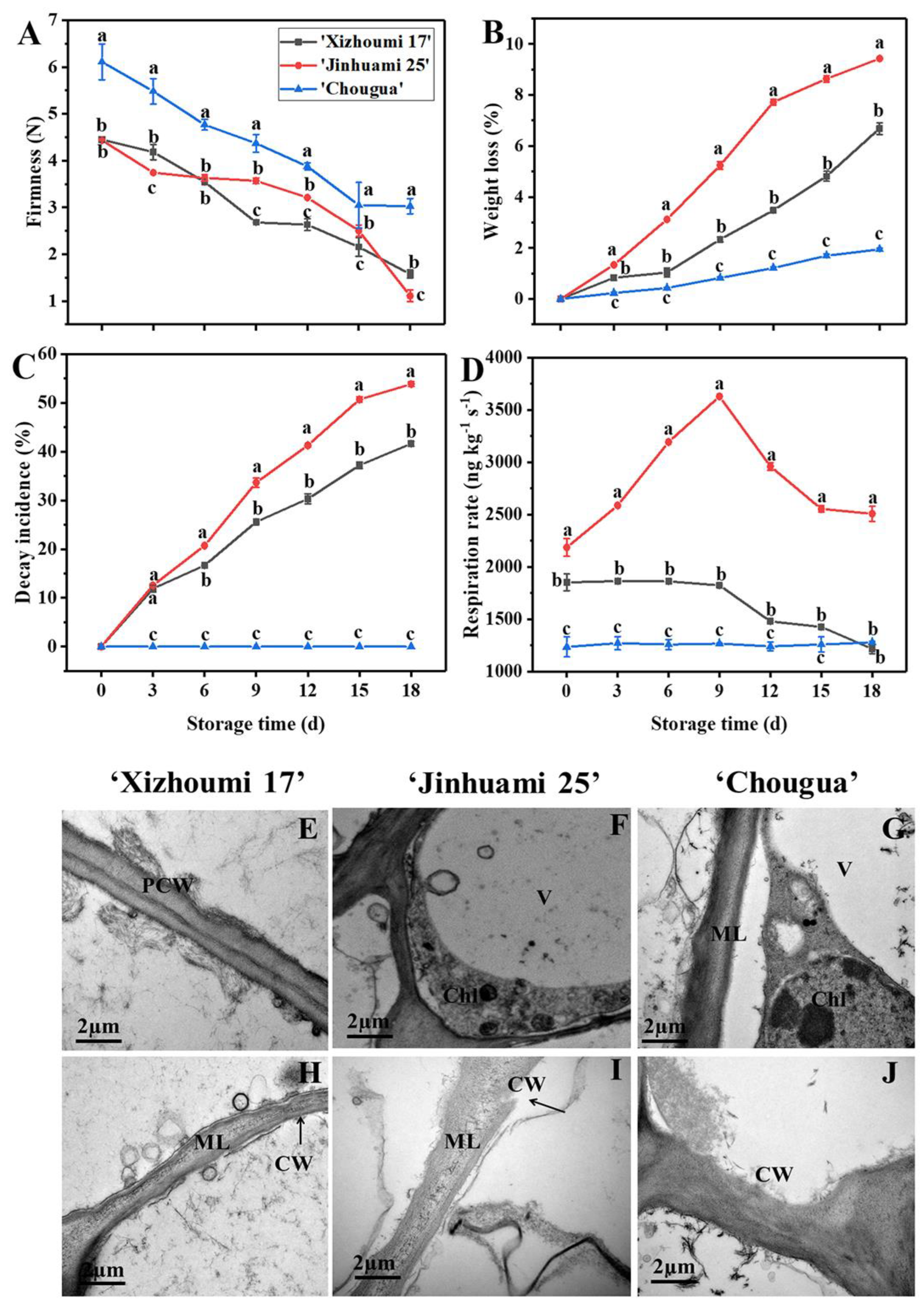
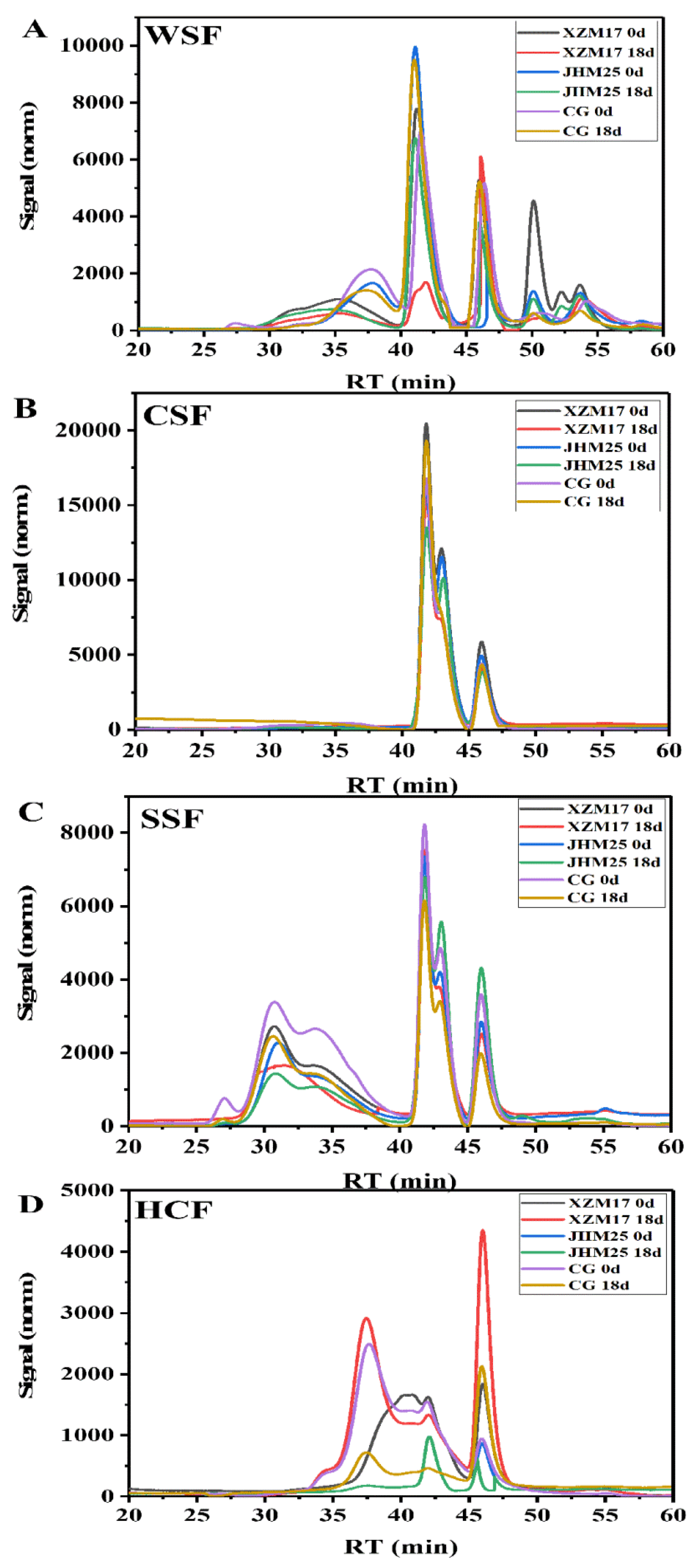
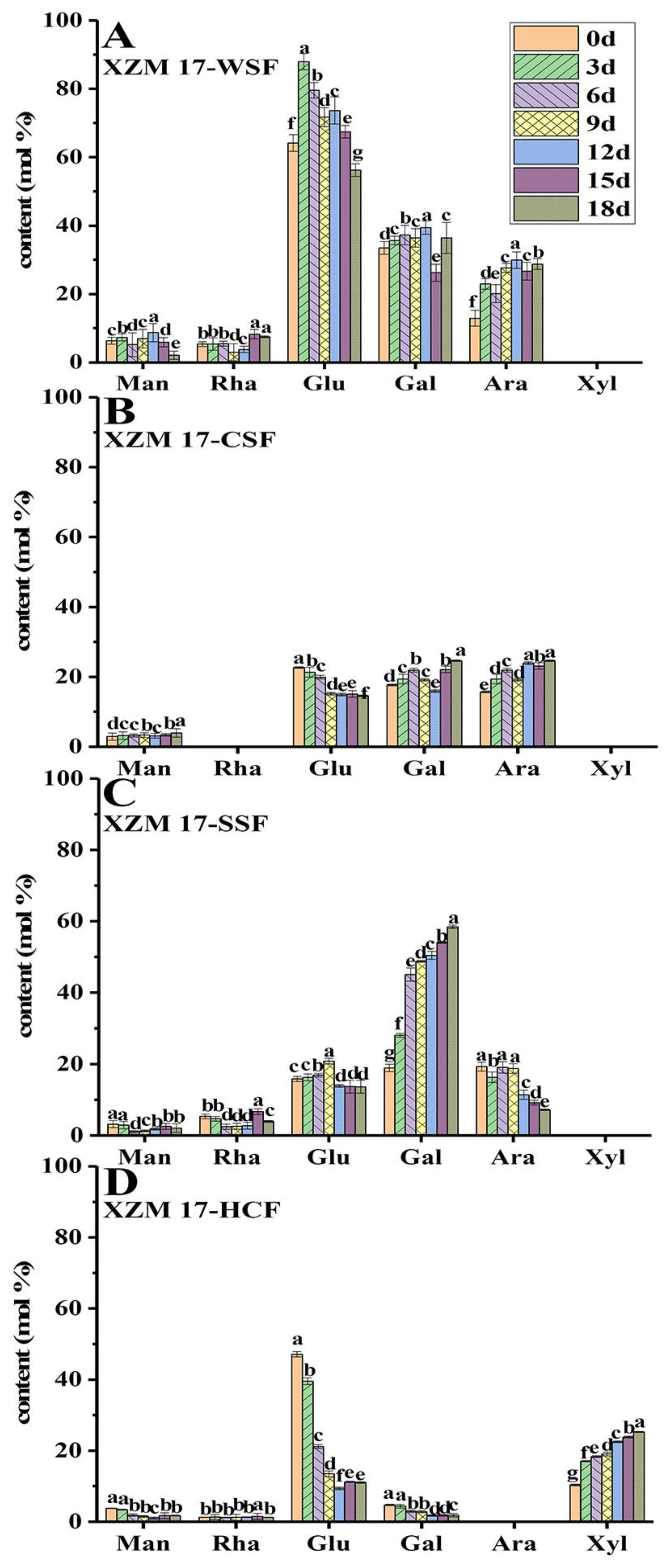
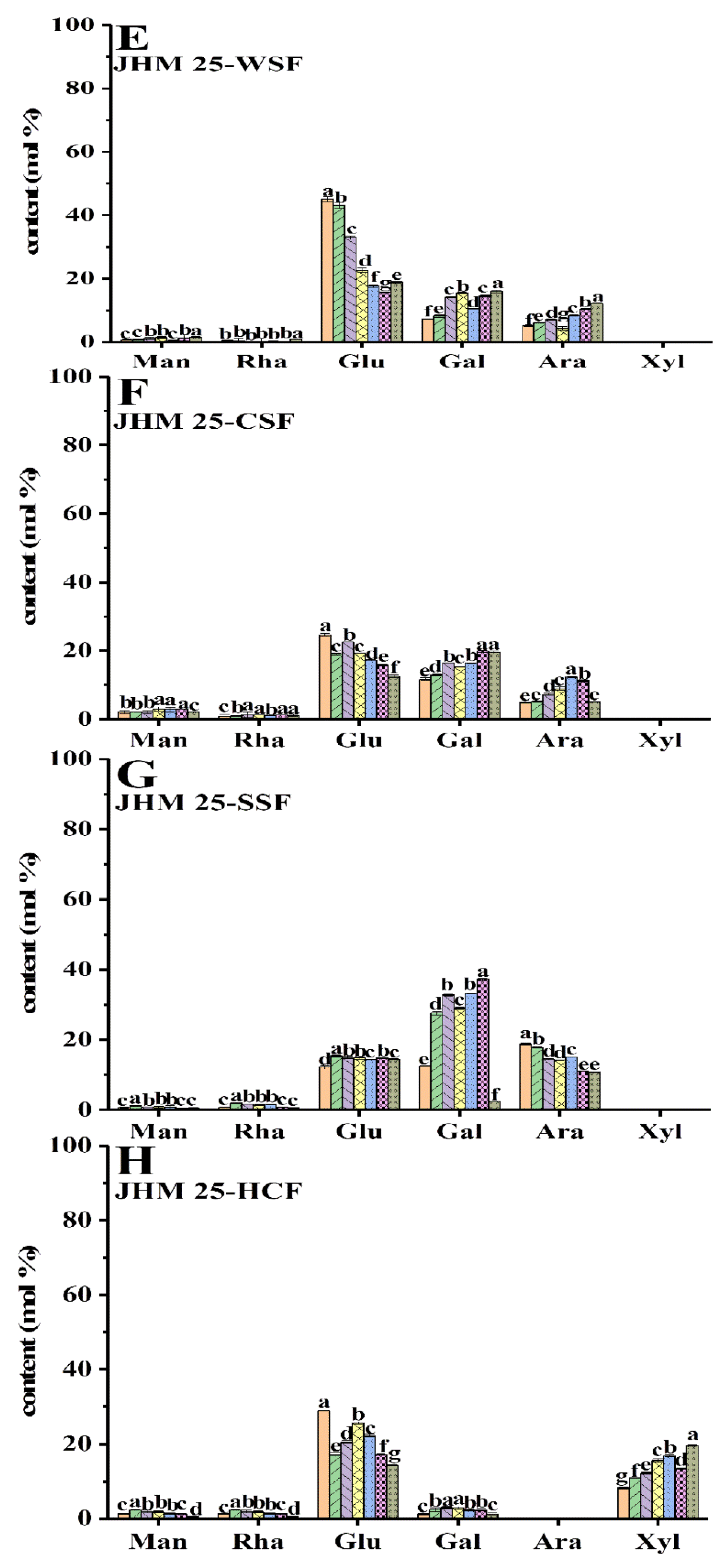
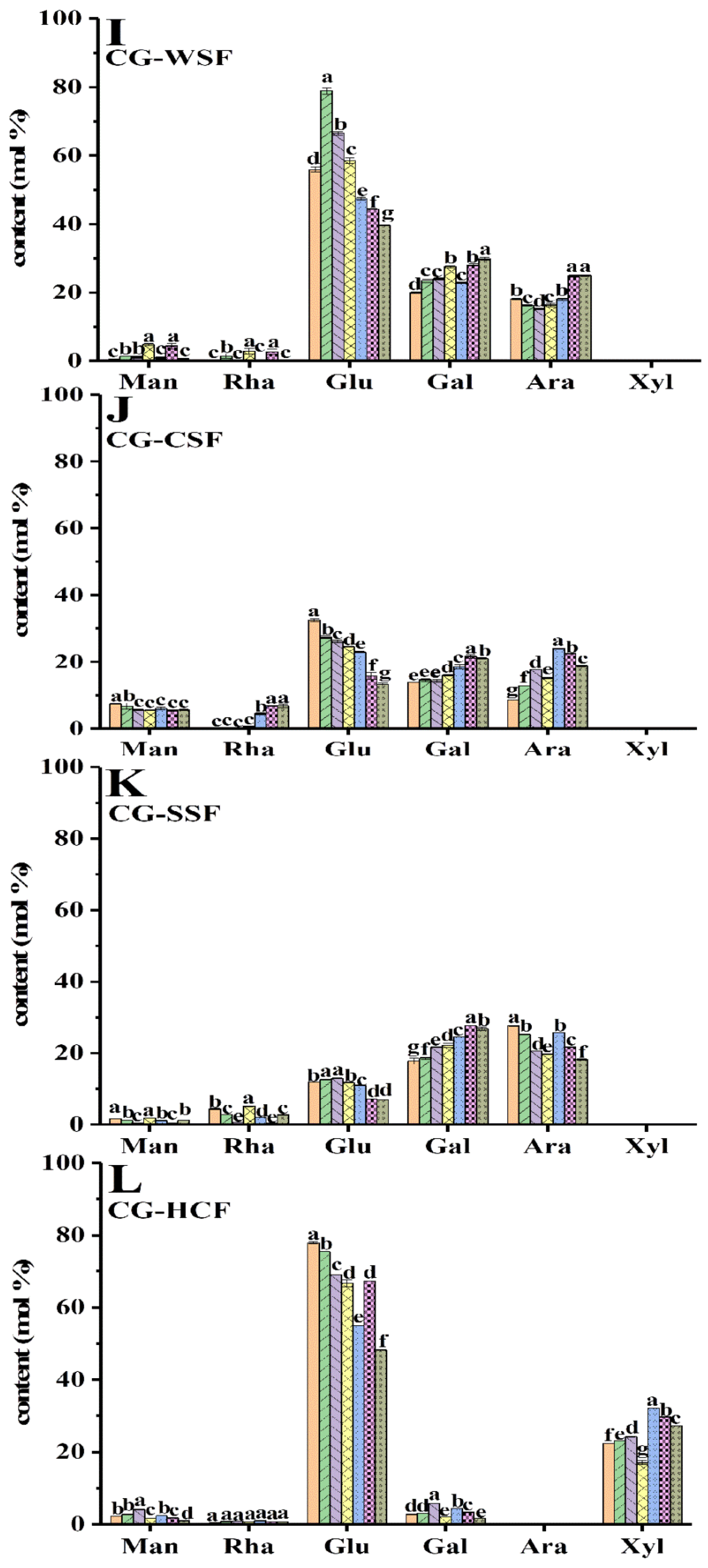
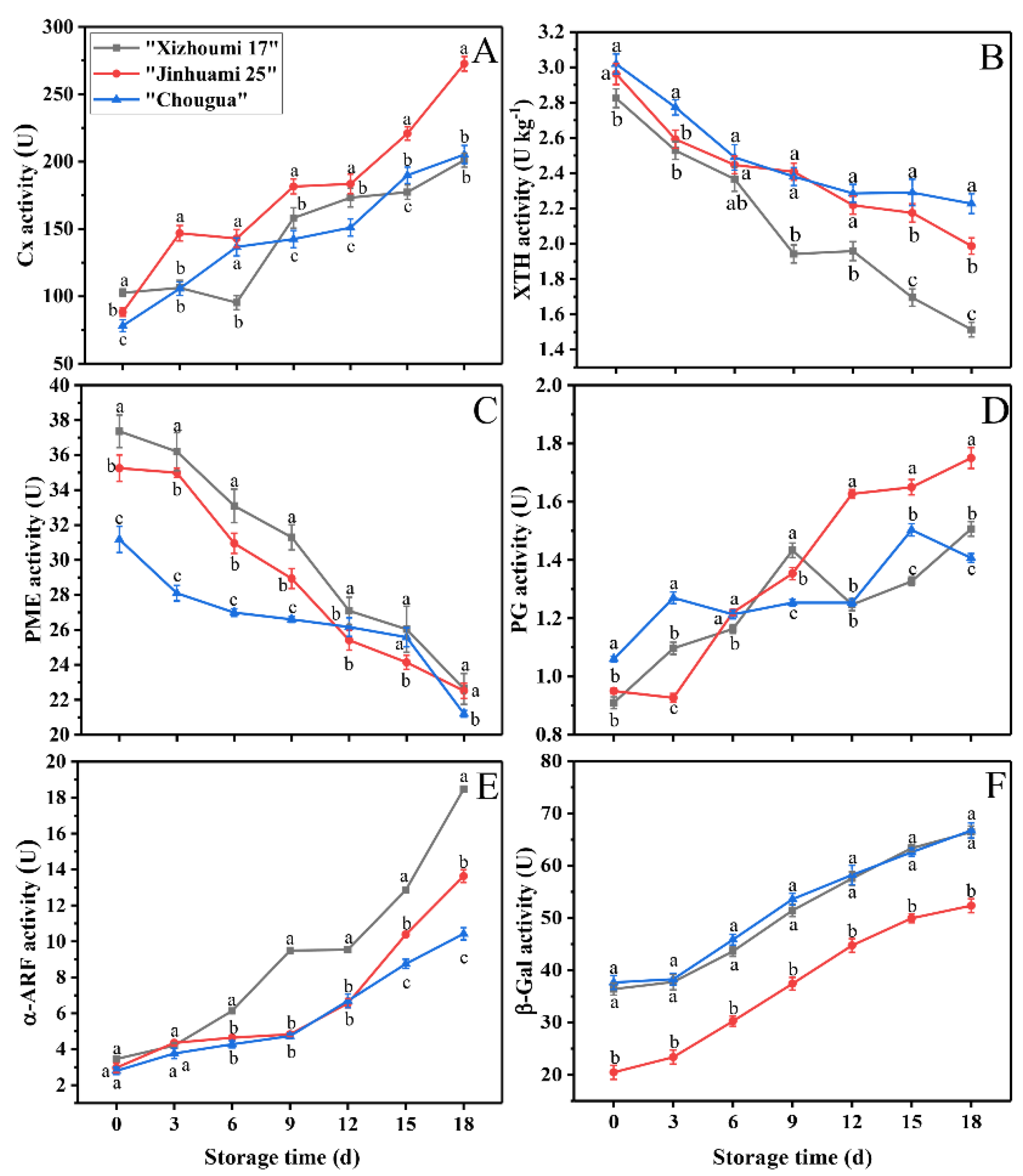
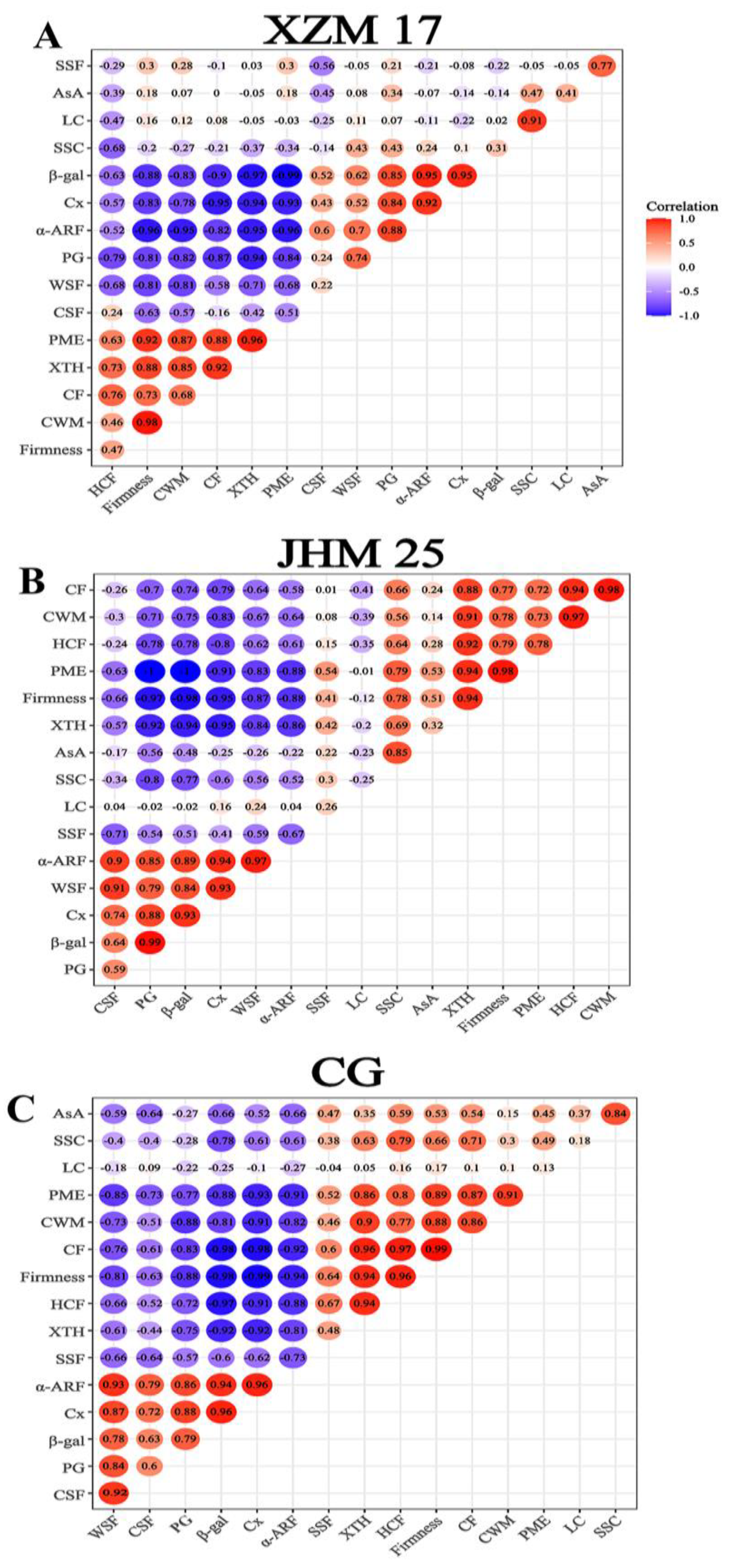
| Storage Time (d) | Length (cm) | Diameter (cm) | SSC (%) | AsA (g kg−1) | CWM (g kg−1) | WSF (g kg−1) | CSF (g kg−1) | SSF (g kg−1) | HCF (g kg−1) | CF (g kg−1) | LC (g kg−1) |
|---|---|---|---|---|---|---|---|---|---|---|---|
| 0 (‘XZM 17’) | 19.20 ± 0.5 a | 13.76 ± 0.4 a | 7.3 ± 0.3 c | 0.19 ± 0.09 f | 0.0505 ± 0 a | 1.4 ± 0 f | 6.3 ± 0.4 b | 5.2 ± 0.7 cd | 0.8 ± 0 a | 0.8 ± 0 a | 0.6 ± 0 c |
| 3 | 19.19 ± 0.2 a | 13.74 ± 0.3 a | 7.7 ± 0.4 c | 0.25 ± 0.07 c | 0.0465 ± 0 b | 17.8 ± 2.3 e | 1.8 ± 0.6 cd | 16.2 ± 0.2 b | 0.5 ± 0 b | 0.6 ± 0 a | 0.6 ± 0 c |
| 6 | 19.11 ± 0.1 a | 13.70 ± 0.5 a | 11.5 ± 0.3 a | 0.33 ± 0.04 b | 0.0420 ± 0 c | 32.5 ± 1.4 c | 3.5 ± 0.2 c | 17.9 ± 0.8 cd | 0.4 ± 0 b | 0.7 ± 0 a | 1.1 ± 0 a |
| 9 | 18.98 ± 0.2 a | 13.56 ± 0.2 a | 9.7 ± 0.4 b | 0.46 ± 0.06 a | 0.0418 ± 0 d | 29.4 ± 4.3 cd | 0.9 ± 0 d | 24.4 ± 2.0 a | 0.3 ± 0 b | 0.3 ± 0 b | 0.8 ± 0 b |
| 12 | 18.93 ± 0.3 a | 13.52 ± 0.4 b | 9.5 ± 0.2 b | 0.17 ± 0.07 g | 0.0413 ± 0 e | 25.0 ± 1.8 d | 1.3 ± 0 cd | 5.7 ± 0.5 cd | 0.3 ± 0 b | 0.2 ± 0 b | 0.8 ± 0 b |
| 15 | 18.89 ± 0.5 b | 13.46 ± 0.3 b | 9.2 ± 0.4 b | 0.21 ± 0.08 e | 0.0383 ± 0 f | 71.4 ± 1.5 b | 10.6 ± 0.1 a | 7.8 ± 1.0 c | 0.4 ± 0 b | 0.3 ± 0 b | 0.8 ± 0 b |
| 18 | 18.85 ± 0.4 b | 13.43 ± 0.2 b | 9.1 ± 0.3 b | 0.23 ± 0.05 d | 0.0366 ± 0 g | 106.2 ± 3.9 a | 10.1 ± 0.5 a | 4.2 ± 0.5 cd | 0.4 ± 0 b | 0.2 ± 0 b | 0.6 ± 0 c |
| 0 (‘JHM 25’) | 25.63 ± 0.6 a | 13.56 ± 0.5 a | 9.6 ± 0.3 a | 0.22 ± 0.04 b | 0.0457 ± 0 a | 16.8 ± 0.9 e | 5.8 ± 0.3 c | 10.0 ± 0.2 c | 0.7 ± 0 a | 0.9 ± 0 a | 0.5 ± 0 b |
| 3 | 25.61 ± 0.4 a | 13.55 ± 0.2 a | 10.2 ± 0.3 a | 0.37 ± 0.03 a | 0.0395 ± 0 b | 36.1 ± 0.8 c | 3.1 ± 0.1 cd | 17.7 ± 0.3 b | 0.4 ± 0 b | 0.4 ± 0 b | 0.6 ± 0 b |
| 6 | 25.56 ± 0.6 a | 13.51 ± 0.3 a | 8.3 ± 0.4 b | 0.17 ± 0.07 e | 0.0389 ± 0 c | 37.9 ± 2.4 c | 3.9 ± 0 c | 18.4 ± 1.1 c | 0.3 ± 0 b | 0.3 ± 0 b | 0.8 ± 0 a |
| 9 | 25.50 ± 0.3 a | 13.47 ± 0.4 a | 8.2 ± 0.4 b | 0.17 ± 0.06 e | 0.0372 ± 0 d | 27.3 ± 1.8 d | 2.9 ± 0.2 d | 24.0 ± 1.8 a | 0.3 ± 0 b | 0.2 ± 0 b | 0.7 ± 0 a |
| 12 | 25.47 ± 0.2 a | 13.43 ± 0.5 a | 8.5 ± 0.3 b | 0.19 ± 0.02 d | 0.0370 ± 0 d | 34.2 ± 0.8 c | 2.1 ± 0 d | 9.2 ± 0.8 c | 0.2 ± 0 b | 0.3 ± 0 b | 0.5 ± 0 b |
| 15 | 25.44 ± 0.5 a | 13.40 ± 0.5 a | 7.9 ± 0.2 bc | 0.20 ± 0.03 c | 0.0343 ± 0 e | 106.7 ± 4.7 b | 12.5 ± 1.6 b | 3.9 ± 0 d | 0.3 ± 0 b | 0.2 ± 0 b | 0.5 ± 0 b |
| 18 | 25.38 ± 0.3 b | 13.34 ± 0.2 b | 8.4 ± 0.3 b | 0.20 ± 0.05 c | 0.0237 ± 0 f | 142.5 ± 6.7 a | 18.6 ± 0.1 a | 3.4 ± 0 d | 0.2 ± 0 b | 0.2 ± 0 b | 0.7 ± 0 a |
| 0 (‘CG’) | 17.56 ± 0.1 a | 12.02 ± 0.5 a | 8.8 ± 0.2 a | 0.23 ± 0.01 f | 0.0528 ± 0 a | 23.3 ± 2.4 d | 7.0 ± 0.9 cd | 19.2 ± 0.6 b | 0.9 ± 0 a | 1.0 ± 0 a | 0.7 ± 0 b |
| 3 | 17.56 ± 0.2 a | 12.01 ± 0.3 a | 9.9 ± 0.3 a | 0.45 ± 0.03 a | 0.0499 ± 0 b | 54.5 ± 3.8 b | 4.9 ± 0.1 d | 19.8 ± 0.1 b | 0.9 ± 0 a | 0.9 ± 0 a | 0.6 ± 0 b |
| 6 | 17.52 ± 0.1 a | 12.01 ± 0.4 a | 9.0 ± 0.1 a | 0.38 ± 0.04 b | 0.0483 ± 0 c | 54.6 ± 3.0 b | 9.1 ± 1.0 c | 23.0 ± 0.3 c | 0.6 ± 0 b | 0.6 ± 0 b | 1.5 ± 0 a |
| 9 | 17.49 ± 0.3 a | 12.00 ± 0.3 a | 8.5 ± 0.5 ab | 0.31 ± 0.04 c | 0.0478 ± 0 d | 46.6 ± 9.1 c | 4.5 ± 0.3 d | 28.4 ± 0.6 a | 0.5 ± 0 b | 0.5 ± 0 bc | 0.6 ± 0 b |
| 12 | 17.49 ± 0.1 a | 11.99 ± 0.5 a | 8.3 ± 0.4 b | 0.27 ± 0.02 d | 0.0478 ± 0 d | 49.2 ± 3.5 bc | 5.3 ± 0.1 d | 8.6 ± 0.9 d | 0.2 ± 0 c | 0.4 ± 0 c | 0.6 ± 0 b |
| 15 | 17.47 ± 0.1 a | 11.98 ± 0.3 a | 8.5 ± 0.3 ab | 0.25 ± 0.08 e | 0.0478 ± 0 d | 51.8 ± 0.2 b | 11.4 ± 0.9 b | 6.9 ± 0.7 de | 0.2 ± 0 c | 0.2 ± 0 d | 0.7 ± 0 b |
| 18 | 17.46 ± 0.2 a | 11.96 ± 0.2 a | 8.3 ± 0.3 b | 0.16 ± 0.05 g | 0.0477 ± 0 d | 70.6 ± 1.0 a | 16.5 ± 0.7 a | 8.5 ± 0.5 d | 0.2 ± 0 c | 0.2 ± 0 d | 0.6 ± 0 b |
Publisher’s Note: MDPI stays neutral with regard to jurisdictional claims in published maps and institutional affiliations. |
© 2022 by the authors. Licensee MDPI, Basel, Switzerland. This article is an open access article distributed under the terms and conditions of the Creative Commons Attribution (CC BY) license (https://creativecommons.org/licenses/by/4.0/).
Share and Cite
Zhang, W.; Guo, M.; Yang, W.; Liu, Y.; Wang, Y.; Chen, G. The Role of Cell Wall Polysaccharides Disassembly and Enzyme Activity Changes in the Softening Process of Hami Melon (Cucumis melo L.). Foods 2022, 11, 841. https://doi.org/10.3390/foods11060841
Zhang W, Guo M, Yang W, Liu Y, Wang Y, Chen G. The Role of Cell Wall Polysaccharides Disassembly and Enzyme Activity Changes in the Softening Process of Hami Melon (Cucumis melo L.). Foods. 2022; 11(6):841. https://doi.org/10.3390/foods11060841
Chicago/Turabian StyleZhang, Weida, Minrui Guo, Wanting Yang, Yuxing Liu, Yue Wang, and Guogang Chen. 2022. "The Role of Cell Wall Polysaccharides Disassembly and Enzyme Activity Changes in the Softening Process of Hami Melon (Cucumis melo L.)" Foods 11, no. 6: 841. https://doi.org/10.3390/foods11060841





